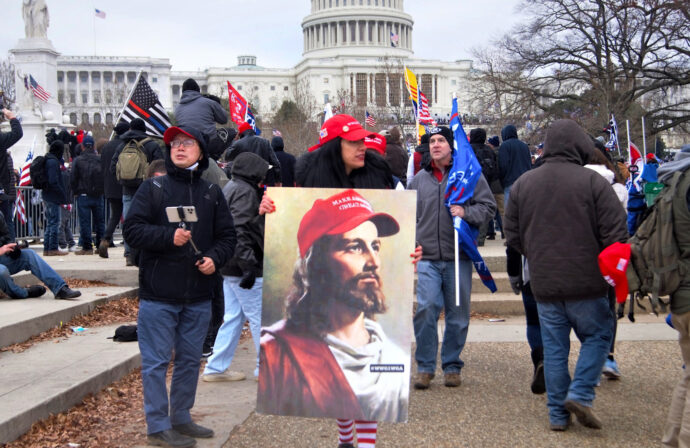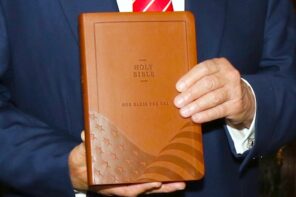Civil war is coming to America. At least that’s the view sizable numbers of Americans have expressed to pollsters in recent years. A 2022 Economist/YouGov poll found that 43% of respondents think it’s likely a civil war will break out over the next decade. Fewer Americans believed civil war would not occur within 10 years than those who believed it would. The poll affirmed the findings of a 2021 national survey by pollster John Zogby who found a plurality of Americans (46%) believed a future civil war was likely.
It is tempting—and comforting—to dismiss such views as far-fetched. The United States, after all, remains the world’s richest, most technologically sophisticated, and most militarily powerful country. It dominates the fields of medical research, artificial intelligence and robotics, aerospace and aviation, higher education, and entertainment. Surely, such a country would be immune from the threat of civil war, wouldn’t it?
Yet, a new American civil war is no longer unthinkable. Political scientist Barbara Walter has identified two specific factors that predict the likelihood of civil war occurrence. Alarmingly, both variables are present in the United States today and are quickly pushing the country to the brink.
The first is “anocracy,” a political science term for countries that mix democratic and autocratic features. These countries are neither democracies nor autocracies, but instead lie somewhere in the middle. Anocracies are prone to conflict because they lack the strong institutions and political channels of robust democracies for citizens to work through; at the same time, they either don’t possess or choose not to use authoritarian tools of repression to undercut violence a priori.
And, according to the Polity Project, the United States is today an anocracy. In 2020, Polity, which focuses on procedural democracy,* downgraded the U.S. score below the “democracy threshold” for the first time in its history. The dramatic drop in America’s democracy score coincided with the Trump administration’s systematic assault on democratic norms and institutions and the 2021 insurrection at the capitol. No longer is the United States the world’s oldest continuous democracy, according to Polity.
Political science research has shown that anocracies are most likely to experience civil war in the first few years of their durations and that transitions into anocracy from democracy (as opposed to transitions into anocracy from autocracy) leave states at a higher risk for civil war. The United States today fits this description perfectly. Indeed, Polity’s analysis places America at “high risk of impending political instability.”
This fact alone is cause for grave concern. But it gets worse.
The second factor identified by Dr. Walter involves the calcification of identity politics among those who had once been politically dominant but now find themselves in decline.
Citizens organizing themselves into an identity-based faction in this way has historically been a warning sign that large scale political violence may be in the offing. People can compromise if the issue at stake is economic or territorial in nature. Land can be divided; money can be reallocated. But how does one compromise on the core issue of identity?
Although the identity fault lines in America are myriad, arguably, the most important cleavage involves race and religion, a cleft created largely by (mostly White) conservative Christians who fear that the country is renouncing its Christian foundations. I have studied cases of mass religious violence around the world in settings as diverse as Egypt, India, Myanmar, Pakistan, and Sri Lanka. At first blush, it may seem that the United States shares little in common with these developing countries. Yet I have found unsettling similarities.
In all these countries, the widespread adoption of a more militant approach stemmed centrally from fears that a historically and culturally dominant religious group was in danger of losing its privileged station. Consequently, these religious communities came to see themselves as the victims of encroachment by minority or non-indigenous religious traditions. Increasingly, members of religious majorities saw violence as an acceptable way to beat back the threat posed by religious heterogeneity.
Whereas religious violence is commonly believed to be a “weapon of the weak” fueled by minority grievances, it is more often a “weapon of the strong” wielded against marginalized and oppressed minority communities. Dr. Walter finds the same when studying the causes of civil war.
We see this same dynamic unfolding in the United States today, the greatest threat stemming from an ideology widely known as “Christian nationalism.” While identity has, of course, always been central to U.S. politics—particularly on the Right—what’s different today is not only the sharp decline in the White Christian majority, but the widespread belief among those who remain that they are persecuted and that their entire way of life is threatened by forces of immigration and social progressivism. As these Christian nationalists scapegoat minorities for the country’s ills, the changing social landscape has led to open calls for violence—the January 6th assault on the capitol complex being only the most infamous example.
According to a survey of more than 6000 Americans conducted earlier this year, adherents of Christian nationalism are almost seven times as likely as rejectors of Christian nationalism to support political violence. Forty percent agreed with the statement “Because things have gotten so far off track, true American patriots may have to resort to violence in order to save our country.” Prominent Christian nationalist leaders, too, such as Mike Huckabee, Rick Joyner, and Greg Locke have warned of or issued calls for mass violence should Christian nationalists not get their way. No longer able to rely on elections to sustain their social and political dominance, an outsized number of Christian nationalists see violence as their last hope.
These voices have been abetted by the rhetoric of far-right politicians. Representative Marjorie Taylor Greene of Georgia has openly called for a “national divorce,” a phrase deliberately chosen to conjure images of the American Civil War. Former president Donald Trump used the apocalyptic language of a “final battle” during his speech at this year’s CPAC conference as a means of framing the 2024 presidential election.
Add to all this the tumult that America has endured over the past decade—an unprecedented global pandemic, a border crisis, an increase in overt and often violent racism, an insurrection, an opioid epidemic, multiple presidential impeachments, the overturn of Roe v. Wade, increasing fallout from climate change—and the fact that the United States is a country awash in guns—and the path to a civil war becomes frighteningly clear.
If America does enter a prolonged period of civil conflict, it will not look the same as its first civil war, a war fought between states. Instead, this war is far more likely to be fought within states and resemble an insurgency, a type of decentralized armed rebellion fought by multiple groups who engage in guerrilla warfare.
It will also be incredibly bloody. Combatants in religious civil wars see themselves as fighting on behalf of both country and God, and are therefore more likely to fight to the death and eschew compromise. For this reason, religious civil wars have been found to be much deadlier and last much longer than non-religious civil wars. Indeed, seemingly disparate incidents—the Capitol insurrection, the scheme to kidnap Michigan Governor Gretchen Whitmer and try her for treason, the brutal beating of Paul Pelosi—may be seen not as a prelude to civil war but as part of its opening salvo.
*The Polity Project has been critiqued for failing to take into account situations like Israel’s disenfranchisement of Palestinians or countries’ commitment to civil liberties and focusing instead on measures of procedural democracy such as constraints on the executive branch. However, other democracy watchdogs like Freedom House, which do account for civil liberties, have also similarly downgraded America’s democracy score over the past several years.





